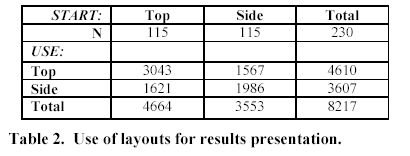
Various studies have shown that much of what people search for is information that they have already seen. Recognizing this, the SIS project designed a search system that provides a unified index over many types of information. The system starts by indexing everything on a user's desktop, and then issues a timestamp every time the user accesses an information resource. This includes Word and pdf files, email messages, web pages that are viewed, and calendar appointments.
The project team designed and evaluated two variations of a search interface for this system. This interface allows for both sorting and filtering by metadata type. The two designs are shown below. They differ only in the placement of and selection interface type for some filtering options. One is called Top View and the other is called Side View.
The team deployed the system for use by 234 people over 6 weeks and collected log file data.
About half of the users (111) started with Sort by Date as the default, and about half (122) started with Sort by Rank as the default. To use a non-default sort option, the user clicks on the sort column above the search results. Table 3 shows the number of sorting operations conducted by both groups as determined by the log files after the 6 week usage period. (N stands for Number of participants in the condition.)

(a) What does this table suggest about user sorting preferences?
In addition, half the participants started with the Top view, and half with the
side view, but they were free to switch views using the Options menu. Table 2
shows the number of uses of each view by both sets of users:

(b) What conclusions can or cannot be drawn from these numbers?
(c) Design an experiment that would better tease out causes behind the
differences in Table 2. Assume that this is also a log-based study and that
participants simply use the system for their work (rather than being assigned
tasks), and that 64 people will participate. Use the structure shown below for
your experiment design.
Hypotheses:
Independent Variables, and their levels:
Dependent Variables, and their levels:
Blocking of experiment, including within-subjects versus
between-subjects, which levels of each factor are used in each condition, how
many participants are in each condition.

